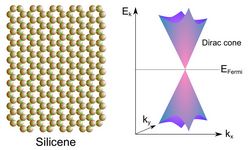Graphene's cousin silicene to revolutionise nanoelectronics
Silicene is a 2D allotrope of silicon, with a hexagonal honeycomb structure similar to that of graphene. Despite graphene's phenomenal properties, its growth over large areas and integration in current silicon-based nanotechnologies are facing important challenges. Experimental synthesis of silicene stimulated tremendous theoretical investigation into its physical properties, in particular its electronic ones. For instance, researchers demonstrated that silicene's band structure resembles that of graphene, featuring Dirac-type electron dispersion in the vicinity of the corners of the hexagonal Brillouin zone. In addition, it was found that silicene can sustain a stable quantum spin Hall effect. Free-standing silicene has been difficult to synthesise until now. Within the SILINANO (Silicene, a new material for nanoelectronics) project, scientists successfully experimented with growing silicene on silver substrates. However, strong interaction between silicene and metals, in this case silver, can be detrimental to silicene's electronic properties. To this end, the team's efforts were aimed at adsorbing organic molecules (metallo-porphyrins) on its surface. Using an experimental technique called angle-resolved photoemission spectroscopy (ARPES), scientists thoroughly studied how the organic molecule properties can affect the electronic structure of the silver-silicene surface. Importantly, researchers successfully upgraded the experimental setup and developed a standard protocol for performing temperature-dependent photoemission experiments. This enabled identification of the most suitable growth conditions for silicene and furthered their understanding of its surface chemistry. The team also experimented with functionalising graphene on an iridium substrate by intercalation of cobalt and forming other covalent 2D-sheet networks using temperature-programmed X-ray photoelectron spectroscopy. An enhanced understanding of the formation of the 2D layer as a function of molecular and co-deposited catalyst coverage should enable the development of such layers on an industrial scale. Combining the properties of silicon and graphene, silicene represents a step forward in the goal for further miniaturisation of nanoelectronics. Unlike its graphene counterpart, silicene has a small bandgap, which makes it suitable for use in nanoelectronics applications, especially for transistors.
Keywords
Graphene, silicene, nanoelectronics, silver, porphyrin, spectroscopy



